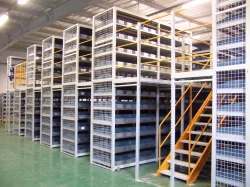Here are key features and considerations related to mezzanine shelving
2024-01-20
Mezzanine shelving refers to a type of elevated storage platform that creates additional storage space within a warehouse or industrial facility. Mezzanines are typically constructed above the ground floor and provide a convenient way to maximize vertical space for storage without the need for major building expansions. Mezzanine shelving systems can be customized to suit specific storage needs and are commonly used in warehouses, distribution centers, and manufacturing facilities. Here are key features and considerations related to mezzanine shelving:
1. Structure and Design:
- Elevated Platform: Mezzanine shelving involves the creation of an elevated platform or floor structure above the ground level.
- Columns and Supports: The mezzanine is supported by columns or pillars, which bear the weight of the structure.
- Railing and Safety Features: Mezzanines typically include safety features such as railings, gates, and toe boards to prevent accidents.
2. Types of Mezzanine Shelving:
- Rack-Supported Mezzanine: Integrates pallet racks or shelving units as the supporting structure for the mezzanine platform.
- Free-Standing Mezzanine: The mezzanine structure is independent of the underlying storage system, allowing for greater flexibility in layout and design.
3. Materials and Construction:
- Steel Construction: Mezzanines are often constructed using steel for its strength and durability.
- Decking Options: Mezzanine floors can be decked with various materials, including steel grating, plywood, or other materials suitable for the intended use.
4. Applications:
- Storage: Mezzanine shelving is primarily used for additional storage space, accommodating palletized goods, cartons, or smaller items.
- Order Picking: Mezzanines are suitable for order picking operations, providing a raised platform for workers to access inventory.
- Office Space: Some mezzanines are designed to include office spaces, break rooms, or other functional areas.
5. Customization and Adaptability:
- Tailored Solutions: Mezzanine shelving systems can be customized to meet specific storage requirements and facility layouts.
- Modular Design: Many mezzanine systems have a modular design, allowing for easy expansion or reconfiguration as storage needs change.
6. Loading and Weight Capacity:
- Structural Integrity: Mezzanine structures are engineered to meet specific load-bearing requirements based on the intended use.
- Weight Distribution: Consideration is given to the weight distribution of stored items to ensure even load distribution across the mezzanine.
7. Integration with Existing Systems:
- Compatibility: Mezzanine shelving can be integrated with existing pallet racking or shelving systems within the facility.
- Material Handling Equipment: Consideration is given to the compatibility with material handling equipment such as forklifts or conveyors.
8. Building Codes and Regulations:
- Compliance: Mezzanine designs must comply with local building codes, safety regulations, and other relevant standards.
- Permitting: Obtaining necessary permits for mezzanine installation is typically required.
9. Installation and Safety:
- Professional Installation: Mezzanine shelving systems are usually installed by professionals to ensure proper assembly and structural integrity.
- Safety Training: Personnel working on or around the mezzanine should receive proper safety training to prevent accidents.
Mezzanine shelving is an effective solution for businesses seeking to optimize their storage space and improve operational efficiency. The design and implementation of mezzanine systems should be carefully planned to meet safety standards and fulfill specific storage needs within an industrial or warehouse setting.



